Social Network Privacy Literature Review
VerifiedAdded on 2019/10/12
|12
|6760
|256
Literature Review
AI Summary
This literature review delves into the critical issue of privacy on social networks, examining the risks associated with sharing personal information online. It explores various definitions of privacy, focusing on information privacy and the challenges users face in managing their online presence. The review covers topics such as privacy settings, user behavior, and the impact of social media on personal data. It also discusses the evolution of privacy policies and the need for increased user awareness and control over their information. The review highlights the importance of privacy in the digital age and the ongoing efforts to protect users from online threats.
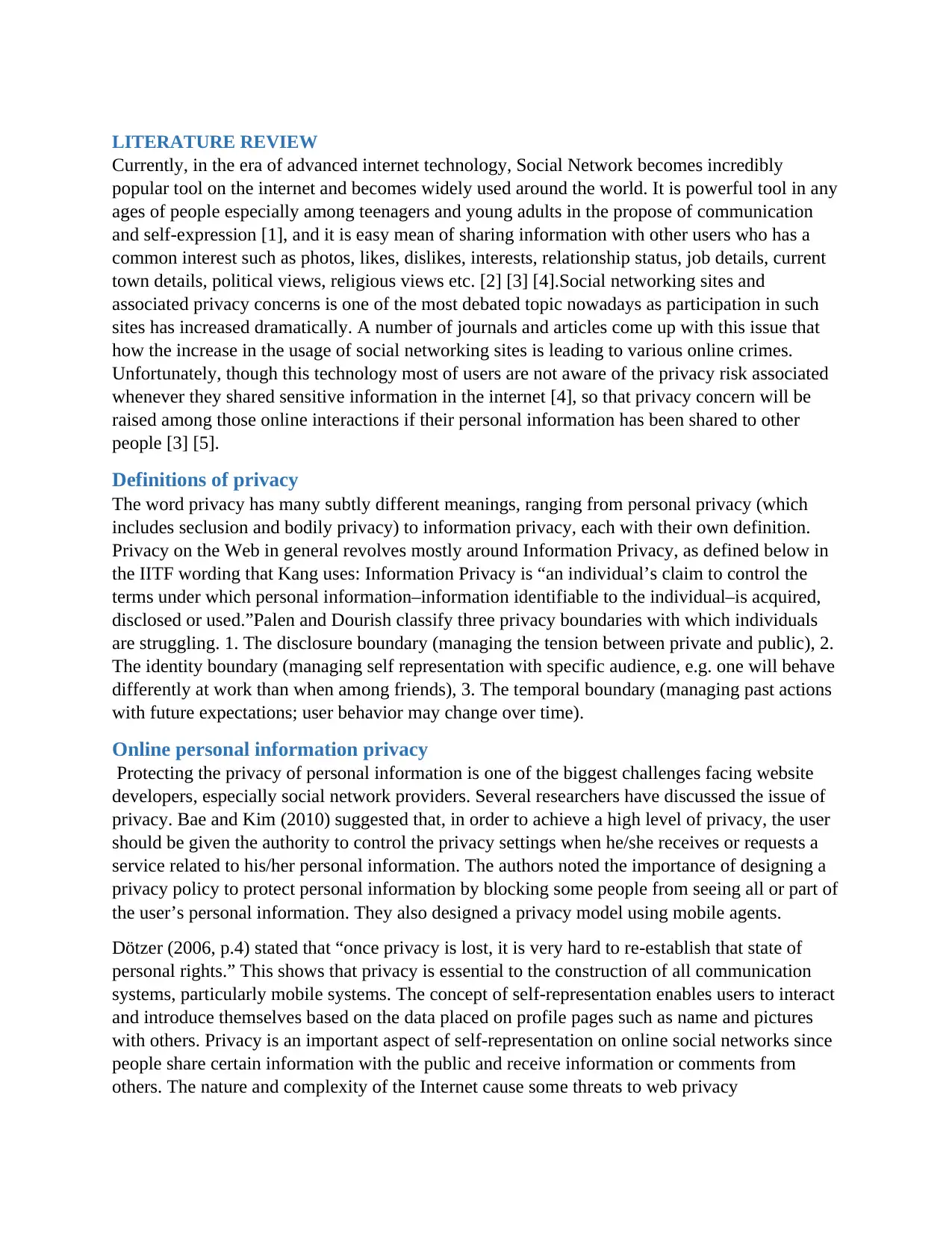
LITERATURE REVIEW
Currently, in the era of advanced internet technology, Social Network becomes incredibly
popular tool on the internet and becomes widely used around the world. It is powerful tool in any
ages of people especially among teenagers and young adults in the propose of communication
and self-expression [1], and it is easy mean of sharing information with other users who has a
common interest such as photos, likes, dislikes, interests, relationship status, job details, current
town details, political views, religious views etc. [2] [3] [4].Social networking sites and
associated privacy concerns is one of the most debated topic nowadays as participation in such
sites has increased dramatically. A number of journals and articles come up with this issue that
how the increase in the usage of social networking sites is leading to various online crimes.
Unfortunately, though this technology most of users are not aware of the privacy risk associated
whenever they shared sensitive information in the internet [4], so that privacy concern will be
raised among those online interactions if their personal information has been shared to other
people [3] [5].
Definitions of privacy
The word privacy has many subtly different meanings, ranging from personal privacy (which
includes seclusion and bodily privacy) to information privacy, each with their own definition.
Privacy on the Web in general revolves mostly around Information Privacy, as defined below in
the IITF wording that Kang uses: Information Privacy is “an individual’s claim to control the
terms under which personal information–information identifiable to the individual–is acquired,
disclosed or used.”Palen and Dourish classify three privacy boundaries with which individuals
are struggling. 1. The disclosure boundary (managing the tension between private and public), 2.
The identity boundary (managing self representation with specific audience, e.g. one will behave
differently at work than when among friends), 3. The temporal boundary (managing past actions
with future expectations; user behavior may change over time).
Online personal information privacy
Protecting the privacy of personal information is one of the biggest challenges facing website
developers, especially social network providers. Several researchers have discussed the issue of
privacy. Bae and Kim (2010) suggested that, in order to achieve a high level of privacy, the user
should be given the authority to control the privacy settings when he/she receives or requests a
service related to his/her personal information. The authors noted the importance of designing a
privacy policy to protect personal information by blocking some people from seeing all or part of
the user’s personal information. They also designed a privacy model using mobile agents.
Dötzer (2006, p.4) stated that “once privacy is lost, it is very hard to re-establish that state of
personal rights.” This shows that privacy is essential to the construction of all communication
systems, particularly mobile systems. The concept of self-representation enables users to interact
and introduce themselves based on the data placed on profile pages such as name and pictures
with others. Privacy is an important aspect of self-representation on online social networks since
people share certain information with the public and receive information or comments from
others. The nature and complexity of the Internet cause some threats to web privacy
Currently, in the era of advanced internet technology, Social Network becomes incredibly
popular tool on the internet and becomes widely used around the world. It is powerful tool in any
ages of people especially among teenagers and young adults in the propose of communication
and self-expression [1], and it is easy mean of sharing information with other users who has a
common interest such as photos, likes, dislikes, interests, relationship status, job details, current
town details, political views, religious views etc. [2] [3] [4].Social networking sites and
associated privacy concerns is one of the most debated topic nowadays as participation in such
sites has increased dramatically. A number of journals and articles come up with this issue that
how the increase in the usage of social networking sites is leading to various online crimes.
Unfortunately, though this technology most of users are not aware of the privacy risk associated
whenever they shared sensitive information in the internet [4], so that privacy concern will be
raised among those online interactions if their personal information has been shared to other
people [3] [5].
Definitions of privacy
The word privacy has many subtly different meanings, ranging from personal privacy (which
includes seclusion and bodily privacy) to information privacy, each with their own definition.
Privacy on the Web in general revolves mostly around Information Privacy, as defined below in
the IITF wording that Kang uses: Information Privacy is “an individual’s claim to control the
terms under which personal information–information identifiable to the individual–is acquired,
disclosed or used.”Palen and Dourish classify three privacy boundaries with which individuals
are struggling. 1. The disclosure boundary (managing the tension between private and public), 2.
The identity boundary (managing self representation with specific audience, e.g. one will behave
differently at work than when among friends), 3. The temporal boundary (managing past actions
with future expectations; user behavior may change over time).
Online personal information privacy
Protecting the privacy of personal information is one of the biggest challenges facing website
developers, especially social network providers. Several researchers have discussed the issue of
privacy. Bae and Kim (2010) suggested that, in order to achieve a high level of privacy, the user
should be given the authority to control the privacy settings when he/she receives or requests a
service related to his/her personal information. The authors noted the importance of designing a
privacy policy to protect personal information by blocking some people from seeing all or part of
the user’s personal information. They also designed a privacy model using mobile agents.
Dötzer (2006, p.4) stated that “once privacy is lost, it is very hard to re-establish that state of
personal rights.” This shows that privacy is essential to the construction of all communication
systems, particularly mobile systems. The concept of self-representation enables users to interact
and introduce themselves based on the data placed on profile pages such as name and pictures
with others. Privacy is an important aspect of self-representation on online social networks since
people share certain information with the public and receive information or comments from
others. The nature and complexity of the Internet cause some threats to web privacy
Paraphrase This Document
Need a fresh take? Get an instant paraphrase of this document with our AI Paraphraser
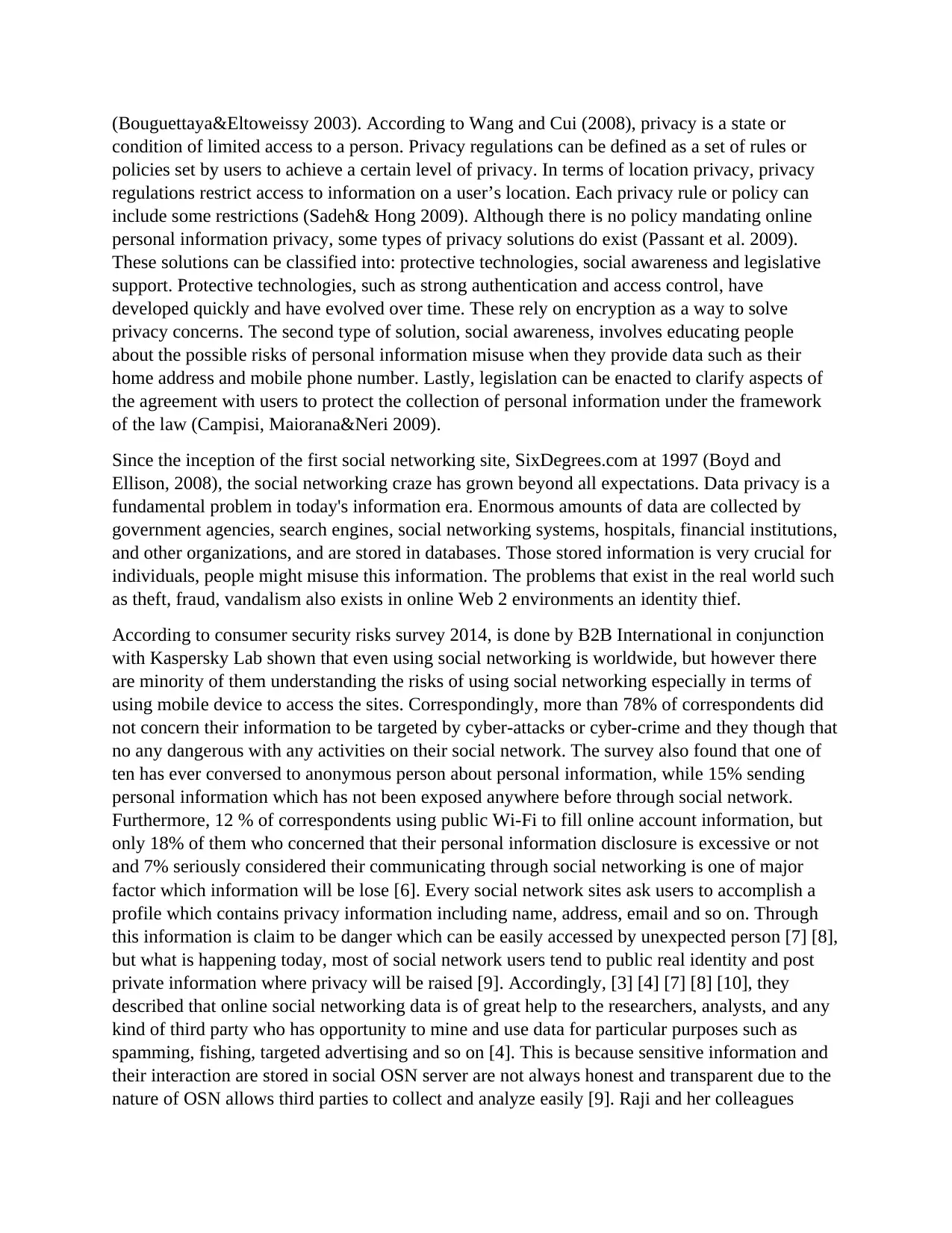
(Bouguettaya&Eltoweissy 2003). According to Wang and Cui (2008), privacy is a state or
condition of limited access to a person. Privacy regulations can be defined as a set of rules or
policies set by users to achieve a certain level of privacy. In terms of location privacy, privacy
regulations restrict access to information on a user’s location. Each privacy rule or policy can
include some restrictions (Sadeh& Hong 2009). Although there is no policy mandating online
personal information privacy, some types of privacy solutions do exist (Passant et al. 2009).
These solutions can be classified into: protective technologies, social awareness and legislative
support. Protective technologies, such as strong authentication and access control, have
developed quickly and have evolved over time. These rely on encryption as a way to solve
privacy concerns. The second type of solution, social awareness, involves educating people
about the possible risks of personal information misuse when they provide data such as their
home address and mobile phone number. Lastly, legislation can be enacted to clarify aspects of
the agreement with users to protect the collection of personal information under the framework
of the law (Campisi, Maiorana&Neri 2009).
Since the inception of the first social networking site, SixDegrees.com at 1997 (Boyd and
Ellison, 2008), the social networking craze has grown beyond all expectations. Data privacy is a
fundamental problem in today's information era. Enormous amounts of data are collected by
government agencies, search engines, social networking systems, hospitals, financial institutions,
and other organizations, and are stored in databases. Those stored information is very crucial for
individuals, people might misuse this information. The problems that exist in the real world such
as theft, fraud, vandalism also exists in online Web 2 environments an identity thief.
According to consumer security risks survey 2014, is done by B2B International in conjunction
with Kaspersky Lab shown that even using social networking is worldwide, but however there
are minority of them understanding the risks of using social networking especially in terms of
using mobile device to access the sites. Correspondingly, more than 78% of correspondents did
not concern their information to be targeted by cyber-attacks or cyber-crime and they though that
no any dangerous with any activities on their social network. The survey also found that one of
ten has ever conversed to anonymous person about personal information, while 15% sending
personal information which has not been exposed anywhere before through social network.
Furthermore, 12 % of correspondents using public Wi-Fi to fill online account information, but
only 18% of them who concerned that their personal information disclosure is excessive or not
and 7% seriously considered their communicating through social networking is one of major
factor which information will be lose [6]. Every social network sites ask users to accomplish a
profile which contains privacy information including name, address, email and so on. Through
this information is claim to be danger which can be easily accessed by unexpected person [7] [8],
but what is happening today, most of social network users tend to public real identity and post
private information where privacy will be raised [9]. Accordingly, [3] [4] [7] [8] [10], they
described that online social networking data is of great help to the researchers, analysts, and any
kind of third party who has opportunity to mine and use data for particular purposes such as
spamming, fishing, targeted advertising and so on [4]. This is because sensitive information and
their interaction are stored in social OSN server are not always honest and transparent due to the
nature of OSN allows third parties to collect and analyze easily [9]. Raji and her colleagues
condition of limited access to a person. Privacy regulations can be defined as a set of rules or
policies set by users to achieve a certain level of privacy. In terms of location privacy, privacy
regulations restrict access to information on a user’s location. Each privacy rule or policy can
include some restrictions (Sadeh& Hong 2009). Although there is no policy mandating online
personal information privacy, some types of privacy solutions do exist (Passant et al. 2009).
These solutions can be classified into: protective technologies, social awareness and legislative
support. Protective technologies, such as strong authentication and access control, have
developed quickly and have evolved over time. These rely on encryption as a way to solve
privacy concerns. The second type of solution, social awareness, involves educating people
about the possible risks of personal information misuse when they provide data such as their
home address and mobile phone number. Lastly, legislation can be enacted to clarify aspects of
the agreement with users to protect the collection of personal information under the framework
of the law (Campisi, Maiorana&Neri 2009).
Since the inception of the first social networking site, SixDegrees.com at 1997 (Boyd and
Ellison, 2008), the social networking craze has grown beyond all expectations. Data privacy is a
fundamental problem in today's information era. Enormous amounts of data are collected by
government agencies, search engines, social networking systems, hospitals, financial institutions,
and other organizations, and are stored in databases. Those stored information is very crucial for
individuals, people might misuse this information. The problems that exist in the real world such
as theft, fraud, vandalism also exists in online Web 2 environments an identity thief.
According to consumer security risks survey 2014, is done by B2B International in conjunction
with Kaspersky Lab shown that even using social networking is worldwide, but however there
are minority of them understanding the risks of using social networking especially in terms of
using mobile device to access the sites. Correspondingly, more than 78% of correspondents did
not concern their information to be targeted by cyber-attacks or cyber-crime and they though that
no any dangerous with any activities on their social network. The survey also found that one of
ten has ever conversed to anonymous person about personal information, while 15% sending
personal information which has not been exposed anywhere before through social network.
Furthermore, 12 % of correspondents using public Wi-Fi to fill online account information, but
only 18% of them who concerned that their personal information disclosure is excessive or not
and 7% seriously considered their communicating through social networking is one of major
factor which information will be lose [6]. Every social network sites ask users to accomplish a
profile which contains privacy information including name, address, email and so on. Through
this information is claim to be danger which can be easily accessed by unexpected person [7] [8],
but what is happening today, most of social network users tend to public real identity and post
private information where privacy will be raised [9]. Accordingly, [3] [4] [7] [8] [10], they
described that online social networking data is of great help to the researchers, analysts, and any
kind of third party who has opportunity to mine and use data for particular purposes such as
spamming, fishing, targeted advertising and so on [4]. This is because sensitive information and
their interaction are stored in social OSN server are not always honest and transparent due to the
nature of OSN allows third parties to collect and analyze easily [9]. Raji and her colleagues
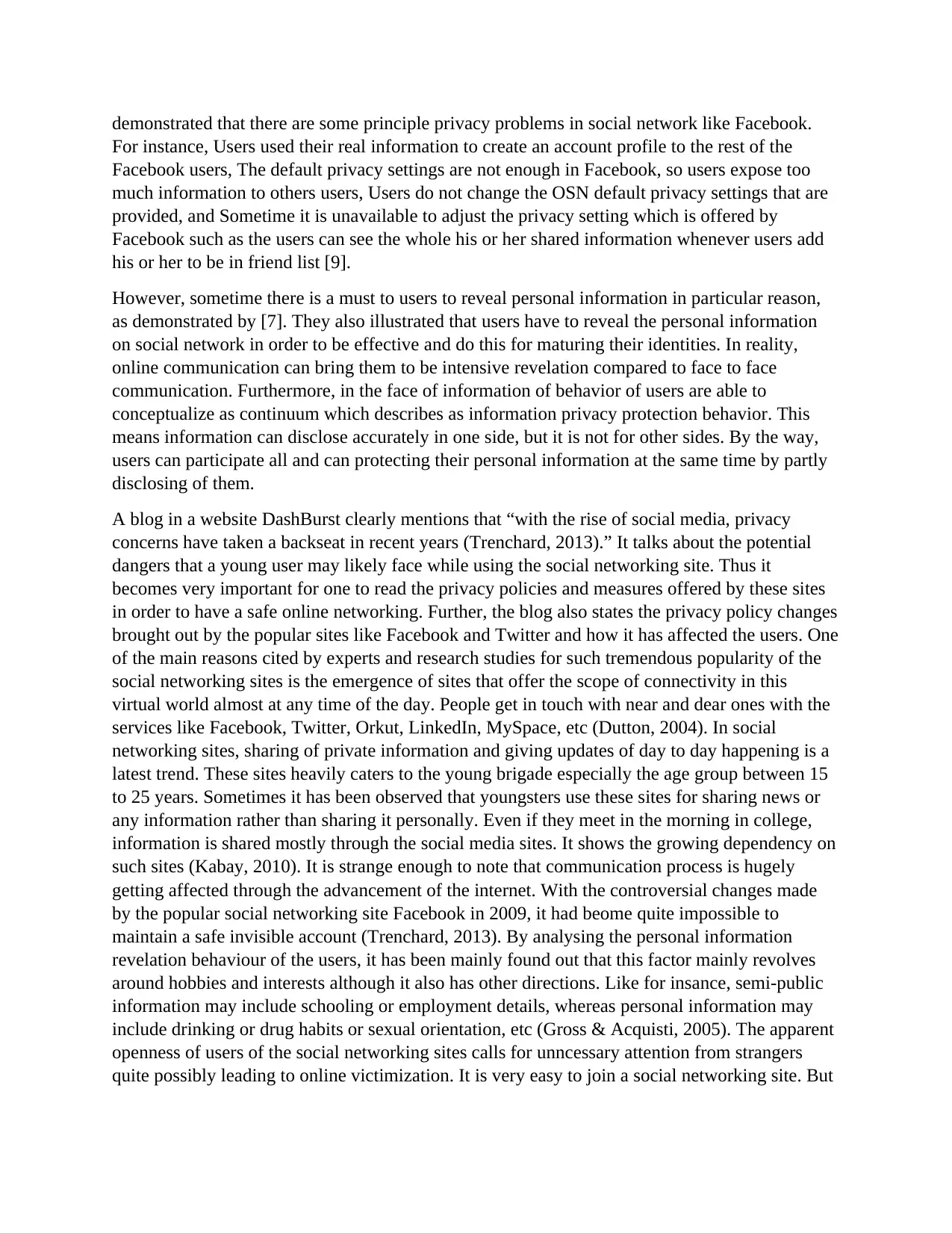
demonstrated that there are some principle privacy problems in social network like Facebook.
For instance, Users used their real information to create an account profile to the rest of the
Facebook users, The default privacy settings are not enough in Facebook, so users expose too
much information to others users, Users do not change the OSN default privacy settings that are
provided, and Sometime it is unavailable to adjust the privacy setting which is offered by
Facebook such as the users can see the whole his or her shared information whenever users add
his or her to be in friend list [9].
However, sometime there is a must to users to reveal personal information in particular reason,
as demonstrated by [7]. They also illustrated that users have to reveal the personal information
on social network in order to be effective and do this for maturing their identities. In reality,
online communication can bring them to be intensive revelation compared to face to face
communication. Furthermore, in the face of information of behavior of users are able to
conceptualize as continuum which describes as information privacy protection behavior. This
means information can disclose accurately in one side, but it is not for other sides. By the way,
users can participate all and can protecting their personal information at the same time by partly
disclosing of them.
A blog in a website DashBurst clearly mentions that “with the rise of social media, privacy
concerns have taken a backseat in recent years (Trenchard, 2013).” It talks about the potential
dangers that a young user may likely face while using the social networking site. Thus it
becomes very important for one to read the privacy policies and measures offered by these sites
in order to have a safe online networking. Further, the blog also states the privacy policy changes
brought out by the popular sites like Facebook and Twitter and how it has affected the users. One
of the main reasons cited by experts and research studies for such tremendous popularity of the
social networking sites is the emergence of sites that offer the scope of connectivity in this
virtual world almost at any time of the day. People get in touch with near and dear ones with the
services like Facebook, Twitter, Orkut, LinkedIn, MySpace, etc (Dutton, 2004). In social
networking sites, sharing of private information and giving updates of day to day happening is a
latest trend. These sites heavily caters to the young brigade especially the age group between 15
to 25 years. Sometimes it has been observed that youngsters use these sites for sharing news or
any information rather than sharing it personally. Even if they meet in the morning in college,
information is shared mostly through the social media sites. It shows the growing dependency on
such sites (Kabay, 2010). It is strange enough to note that communication process is hugely
getting affected through the advancement of the internet. With the controversial changes made
by the popular social networking site Facebook in 2009, it had beome quite impossible to
maintain a safe invisible account (Trenchard, 2013). By analysing the personal information
revelation behaviour of the users, it has been mainly found out that this factor mainly revolves
around hobbies and interests although it also has other directions. Like for insance, semi-public
information may include schooling or employment details, whereas personal information may
include drinking or drug habits or sexual orientation, etc (Gross & Acquisti, 2005). The apparent
openness of users of the social networking sites calls for unncessary attention from strangers
quite possibly leading to online victimization. It is very easy to join a social networking site. But
For instance, Users used their real information to create an account profile to the rest of the
Facebook users, The default privacy settings are not enough in Facebook, so users expose too
much information to others users, Users do not change the OSN default privacy settings that are
provided, and Sometime it is unavailable to adjust the privacy setting which is offered by
Facebook such as the users can see the whole his or her shared information whenever users add
his or her to be in friend list [9].
However, sometime there is a must to users to reveal personal information in particular reason,
as demonstrated by [7]. They also illustrated that users have to reveal the personal information
on social network in order to be effective and do this for maturing their identities. In reality,
online communication can bring them to be intensive revelation compared to face to face
communication. Furthermore, in the face of information of behavior of users are able to
conceptualize as continuum which describes as information privacy protection behavior. This
means information can disclose accurately in one side, but it is not for other sides. By the way,
users can participate all and can protecting their personal information at the same time by partly
disclosing of them.
A blog in a website DashBurst clearly mentions that “with the rise of social media, privacy
concerns have taken a backseat in recent years (Trenchard, 2013).” It talks about the potential
dangers that a young user may likely face while using the social networking site. Thus it
becomes very important for one to read the privacy policies and measures offered by these sites
in order to have a safe online networking. Further, the blog also states the privacy policy changes
brought out by the popular sites like Facebook and Twitter and how it has affected the users. One
of the main reasons cited by experts and research studies for such tremendous popularity of the
social networking sites is the emergence of sites that offer the scope of connectivity in this
virtual world almost at any time of the day. People get in touch with near and dear ones with the
services like Facebook, Twitter, Orkut, LinkedIn, MySpace, etc (Dutton, 2004). In social
networking sites, sharing of private information and giving updates of day to day happening is a
latest trend. These sites heavily caters to the young brigade especially the age group between 15
to 25 years. Sometimes it has been observed that youngsters use these sites for sharing news or
any information rather than sharing it personally. Even if they meet in the morning in college,
information is shared mostly through the social media sites. It shows the growing dependency on
such sites (Kabay, 2010). It is strange enough to note that communication process is hugely
getting affected through the advancement of the internet. With the controversial changes made
by the popular social networking site Facebook in 2009, it had beome quite impossible to
maintain a safe invisible account (Trenchard, 2013). By analysing the personal information
revelation behaviour of the users, it has been mainly found out that this factor mainly revolves
around hobbies and interests although it also has other directions. Like for insance, semi-public
information may include schooling or employment details, whereas personal information may
include drinking or drug habits or sexual orientation, etc (Gross & Acquisti, 2005). The apparent
openness of users of the social networking sites calls for unncessary attention from strangers
quite possibly leading to online victimization. It is very easy to join a social networking site. But
⊘ This is a preview!⊘
Do you want full access?
Subscribe today to unlock all pages.

Trusted by 1+ million students worldwide
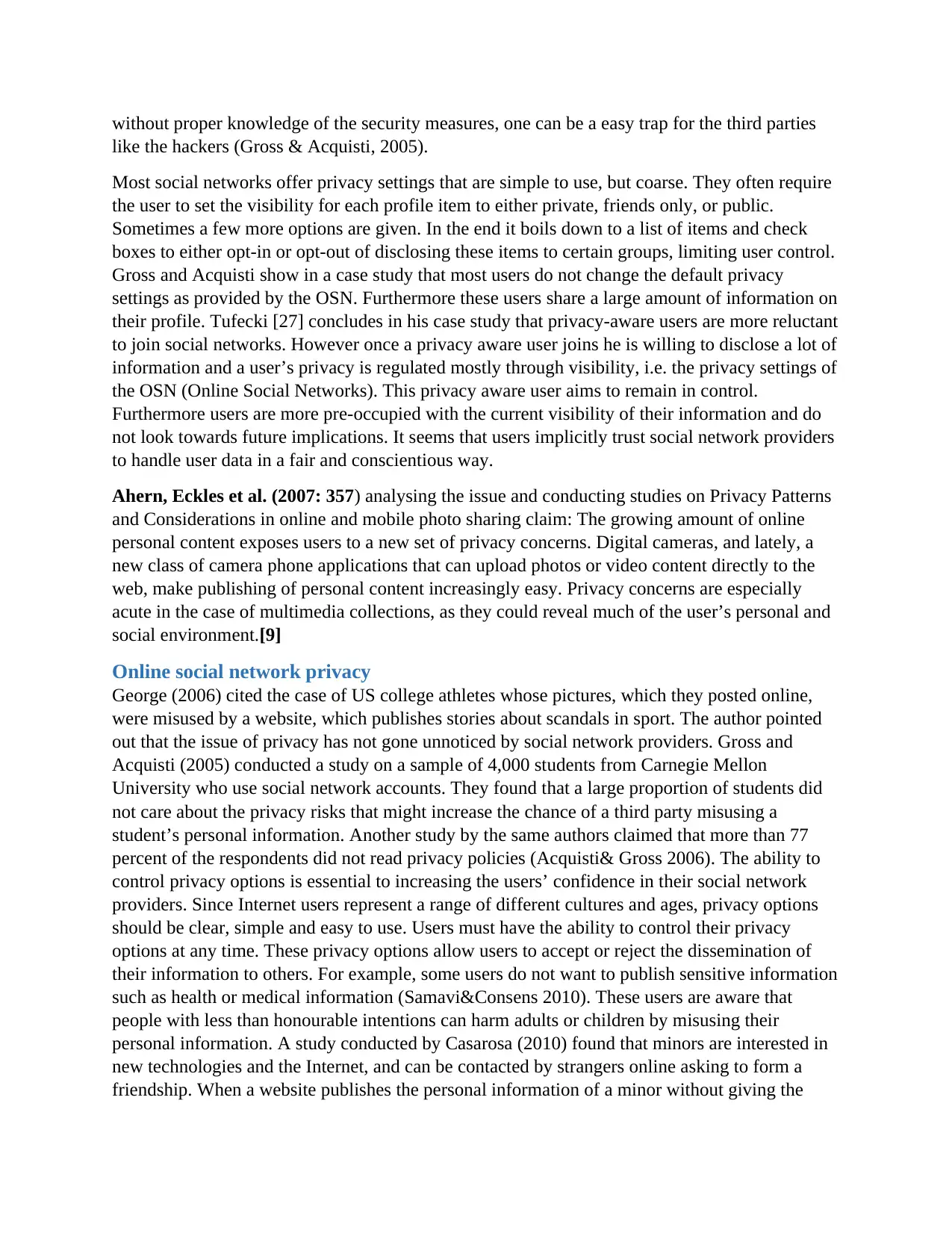
without proper knowledge of the security measures, one can be a easy trap for the third parties
like the hackers (Gross & Acquisti, 2005).
Most social networks offer privacy settings that are simple to use, but coarse. They often require
the user to set the visibility for each profile item to either private, friends only, or public.
Sometimes a few more options are given. In the end it boils down to a list of items and check
boxes to either opt-in or opt-out of disclosing these items to certain groups, limiting user control.
Gross and Acquisti show in a case study that most users do not change the default privacy
settings as provided by the OSN. Furthermore these users share a large amount of information on
their profile. Tufecki [27] concludes in his case study that privacy-aware users are more reluctant
to join social networks. However once a privacy aware user joins he is willing to disclose a lot of
information and a user’s privacy is regulated mostly through visibility, i.e. the privacy settings of
the OSN (Online Social Networks). This privacy aware user aims to remain in control.
Furthermore users are more pre-occupied with the current visibility of their information and do
not look towards future implications. It seems that users implicitly trust social network providers
to handle user data in a fair and conscientious way.
Ahern, Eckles et al. (2007: 357) analysing the issue and conducting studies on Privacy Patterns
and Considerations in online and mobile photo sharing claim: The growing amount of online
personal content exposes users to a new set of privacy concerns. Digital cameras, and lately, a
new class of camera phone applications that can upload photos or video content directly to the
web, make publishing of personal content increasingly easy. Privacy concerns are especially
acute in the case of multimedia collections, as they could reveal much of the user’s personal and
social environment.[9]
Online social network privacy
George (2006) cited the case of US college athletes whose pictures, which they posted online,
were misused by a website, which publishes stories about scandals in sport. The author pointed
out that the issue of privacy has not gone unnoticed by social network providers. Gross and
Acquisti (2005) conducted a study on a sample of 4,000 students from Carnegie Mellon
University who use social network accounts. They found that a large proportion of students did
not care about the privacy risks that might increase the chance of a third party misusing a
student’s personal information. Another study by the same authors claimed that more than 77
percent of the respondents did not read privacy policies (Acquisti& Gross 2006). The ability to
control privacy options is essential to increasing the users’ confidence in their social network
providers. Since Internet users represent a range of different cultures and ages, privacy options
should be clear, simple and easy to use. Users must have the ability to control their privacy
options at any time. These privacy options allow users to accept or reject the dissemination of
their information to others. For example, some users do not want to publish sensitive information
such as health or medical information (Samavi&Consens 2010). These users are aware that
people with less than honourable intentions can harm adults or children by misusing their
personal information. A study conducted by Casarosa (2010) found that minors are interested in
new technologies and the Internet, and can be contacted by strangers online asking to form a
friendship. When a website publishes the personal information of a minor without giving the
like the hackers (Gross & Acquisti, 2005).
Most social networks offer privacy settings that are simple to use, but coarse. They often require
the user to set the visibility for each profile item to either private, friends only, or public.
Sometimes a few more options are given. In the end it boils down to a list of items and check
boxes to either opt-in or opt-out of disclosing these items to certain groups, limiting user control.
Gross and Acquisti show in a case study that most users do not change the default privacy
settings as provided by the OSN. Furthermore these users share a large amount of information on
their profile. Tufecki [27] concludes in his case study that privacy-aware users are more reluctant
to join social networks. However once a privacy aware user joins he is willing to disclose a lot of
information and a user’s privacy is regulated mostly through visibility, i.e. the privacy settings of
the OSN (Online Social Networks). This privacy aware user aims to remain in control.
Furthermore users are more pre-occupied with the current visibility of their information and do
not look towards future implications. It seems that users implicitly trust social network providers
to handle user data in a fair and conscientious way.
Ahern, Eckles et al. (2007: 357) analysing the issue and conducting studies on Privacy Patterns
and Considerations in online and mobile photo sharing claim: The growing amount of online
personal content exposes users to a new set of privacy concerns. Digital cameras, and lately, a
new class of camera phone applications that can upload photos or video content directly to the
web, make publishing of personal content increasingly easy. Privacy concerns are especially
acute in the case of multimedia collections, as they could reveal much of the user’s personal and
social environment.[9]
Online social network privacy
George (2006) cited the case of US college athletes whose pictures, which they posted online,
were misused by a website, which publishes stories about scandals in sport. The author pointed
out that the issue of privacy has not gone unnoticed by social network providers. Gross and
Acquisti (2005) conducted a study on a sample of 4,000 students from Carnegie Mellon
University who use social network accounts. They found that a large proportion of students did
not care about the privacy risks that might increase the chance of a third party misusing a
student’s personal information. Another study by the same authors claimed that more than 77
percent of the respondents did not read privacy policies (Acquisti& Gross 2006). The ability to
control privacy options is essential to increasing the users’ confidence in their social network
providers. Since Internet users represent a range of different cultures and ages, privacy options
should be clear, simple and easy to use. Users must have the ability to control their privacy
options at any time. These privacy options allow users to accept or reject the dissemination of
their information to others. For example, some users do not want to publish sensitive information
such as health or medical information (Samavi&Consens 2010). These users are aware that
people with less than honourable intentions can harm adults or children by misusing their
personal information. A study conducted by Casarosa (2010) found that minors are interested in
new technologies and the Internet, and can be contacted by strangers online asking to form a
friendship. When a website publishes the personal information of a minor without giving the
Paraphrase This Document
Need a fresh take? Get an instant paraphrase of this document with our AI Paraphraser
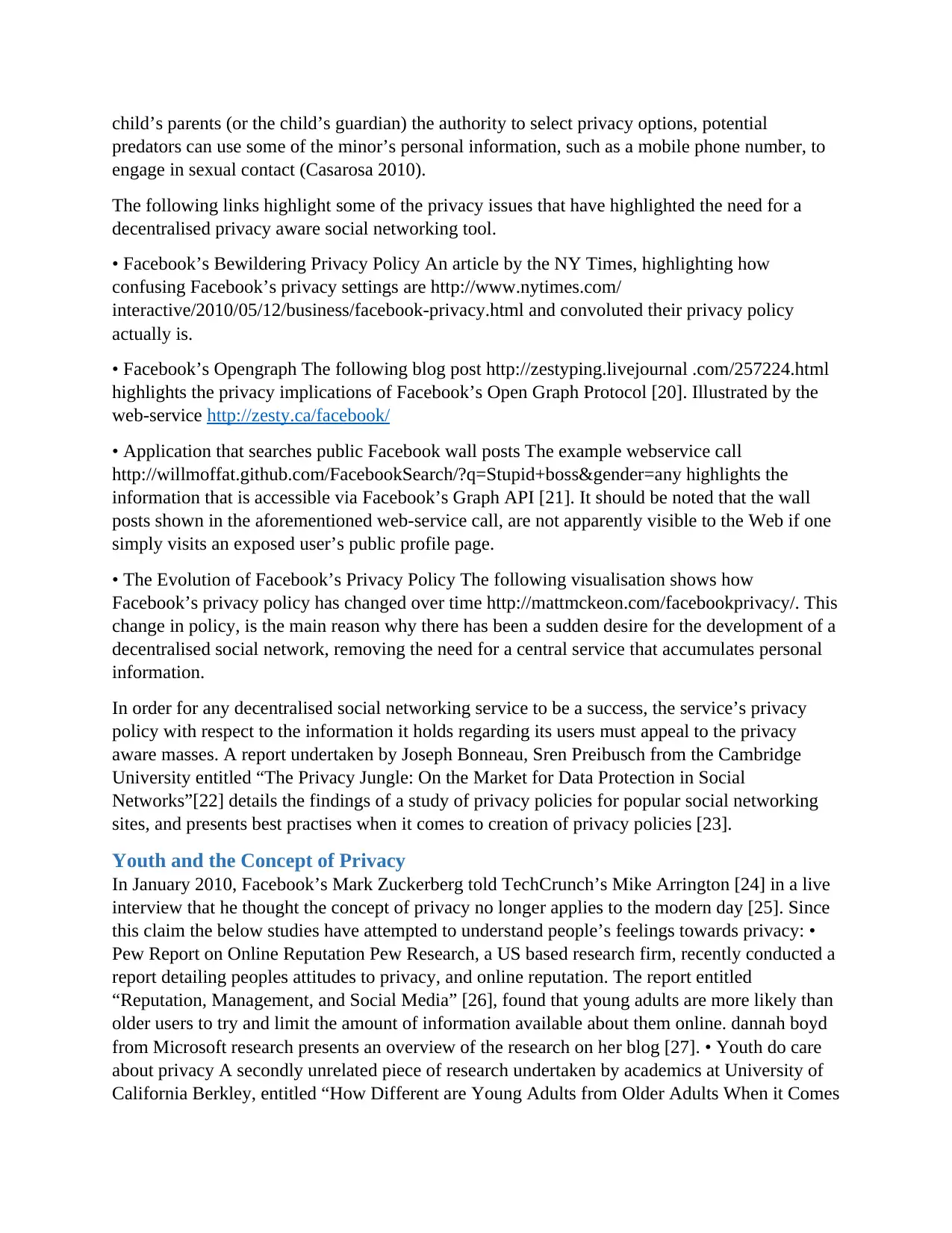
child’s parents (or the child’s guardian) the authority to select privacy options, potential
predators can use some of the minor’s personal information, such as a mobile phone number, to
engage in sexual contact (Casarosa 2010).
The following links highlight some of the privacy issues that have highlighted the need for a
decentralised privacy aware social networking tool.
• Facebook’s Bewildering Privacy Policy An article by the NY Times, highlighting how
confusing Facebook’s privacy settings are http://www.nytimes.com/
interactive/2010/05/12/business/facebook-privacy.html and convoluted their privacy policy
actually is.
• Facebook’s Opengraph The following blog post http://zestyping.livejournal .com/257224.html
highlights the privacy implications of Facebook’s Open Graph Protocol [20]. Illustrated by the
web-service http://zesty.ca/facebook/
• Application that searches public Facebook wall posts The example webservice call
http://willmoffat.github.com/FacebookSearch/?q=Stupid+boss&gender=any highlights the
information that is accessible via Facebook’s Graph API [21]. It should be noted that the wall
posts shown in the aforementioned web-service call, are not apparently visible to the Web if one
simply visits an exposed user’s public profile page.
• The Evolution of Facebook’s Privacy Policy The following visualisation shows how
Facebook’s privacy policy has changed over time http://mattmckeon.com/facebookprivacy/. This
change in policy, is the main reason why there has been a sudden desire for the development of a
decentralised social network, removing the need for a central service that accumulates personal
information.
In order for any decentralised social networking service to be a success, the service’s privacy
policy with respect to the information it holds regarding its users must appeal to the privacy
aware masses. A report undertaken by Joseph Bonneau, Sren Preibusch from the Cambridge
University entitled “The Privacy Jungle: On the Market for Data Protection in Social
Networks”[22] details the findings of a study of privacy policies for popular social networking
sites, and presents best practises when it comes to creation of privacy policies [23].
Youth and the Concept of Privacy
In January 2010, Facebook’s Mark Zuckerberg told TechCrunch’s Mike Arrington [24] in a live
interview that he thought the concept of privacy no longer applies to the modern day [25]. Since
this claim the below studies have attempted to understand people’s feelings towards privacy: •
Pew Report on Online Reputation Pew Research, a US based research firm, recently conducted a
report detailing peoples attitudes to privacy, and online reputation. The report entitled
“Reputation, Management, and Social Media” [26], found that young adults are more likely than
older users to try and limit the amount of information available about them online. dannah boyd
from Microsoft research presents an overview of the research on her blog [27]. • Youth do care
about privacy A secondly unrelated piece of research undertaken by academics at University of
California Berkley, entitled “How Different are Young Adults from Older Adults When it Comes
predators can use some of the minor’s personal information, such as a mobile phone number, to
engage in sexual contact (Casarosa 2010).
The following links highlight some of the privacy issues that have highlighted the need for a
decentralised privacy aware social networking tool.
• Facebook’s Bewildering Privacy Policy An article by the NY Times, highlighting how
confusing Facebook’s privacy settings are http://www.nytimes.com/
interactive/2010/05/12/business/facebook-privacy.html and convoluted their privacy policy
actually is.
• Facebook’s Opengraph The following blog post http://zestyping.livejournal .com/257224.html
highlights the privacy implications of Facebook’s Open Graph Protocol [20]. Illustrated by the
web-service http://zesty.ca/facebook/
• Application that searches public Facebook wall posts The example webservice call
http://willmoffat.github.com/FacebookSearch/?q=Stupid+boss&gender=any highlights the
information that is accessible via Facebook’s Graph API [21]. It should be noted that the wall
posts shown in the aforementioned web-service call, are not apparently visible to the Web if one
simply visits an exposed user’s public profile page.
• The Evolution of Facebook’s Privacy Policy The following visualisation shows how
Facebook’s privacy policy has changed over time http://mattmckeon.com/facebookprivacy/. This
change in policy, is the main reason why there has been a sudden desire for the development of a
decentralised social network, removing the need for a central service that accumulates personal
information.
In order for any decentralised social networking service to be a success, the service’s privacy
policy with respect to the information it holds regarding its users must appeal to the privacy
aware masses. A report undertaken by Joseph Bonneau, Sren Preibusch from the Cambridge
University entitled “The Privacy Jungle: On the Market for Data Protection in Social
Networks”[22] details the findings of a study of privacy policies for popular social networking
sites, and presents best practises when it comes to creation of privacy policies [23].
Youth and the Concept of Privacy
In January 2010, Facebook’s Mark Zuckerberg told TechCrunch’s Mike Arrington [24] in a live
interview that he thought the concept of privacy no longer applies to the modern day [25]. Since
this claim the below studies have attempted to understand people’s feelings towards privacy: •
Pew Report on Online Reputation Pew Research, a US based research firm, recently conducted a
report detailing peoples attitudes to privacy, and online reputation. The report entitled
“Reputation, Management, and Social Media” [26], found that young adults are more likely than
older users to try and limit the amount of information available about them online. dannah boyd
from Microsoft research presents an overview of the research on her blog [27]. • Youth do care
about privacy A secondly unrelated piece of research undertaken by academics at University of
California Berkley, entitled “How Different are Young Adults from Older Adults When it Comes
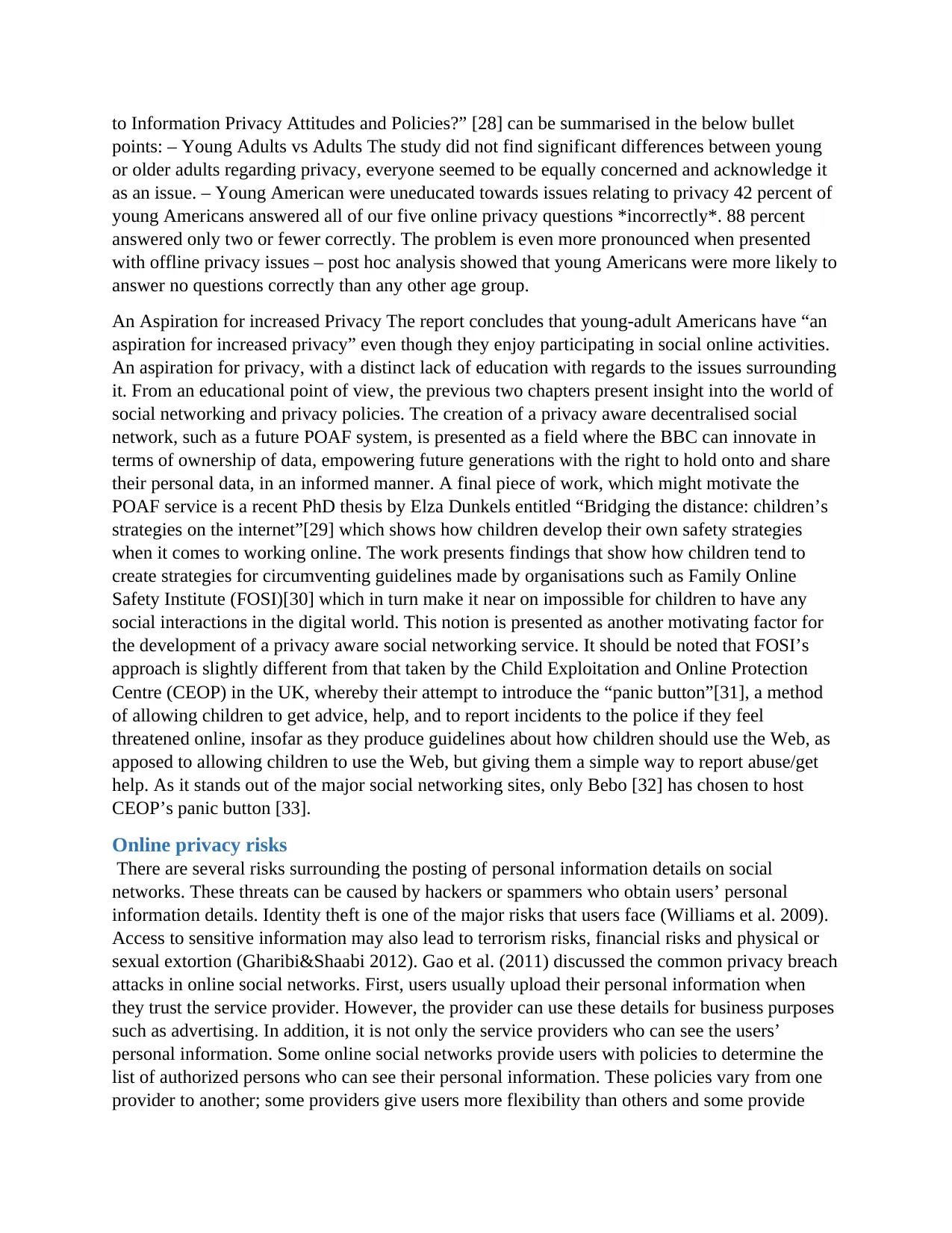
to Information Privacy Attitudes and Policies?” [28] can be summarised in the below bullet
points: – Young Adults vs Adults The study did not find significant differences between young
or older adults regarding privacy, everyone seemed to be equally concerned and acknowledge it
as an issue. – Young American were uneducated towards issues relating to privacy 42 percent of
young Americans answered all of our five online privacy questions *incorrectly*. 88 percent
answered only two or fewer correctly. The problem is even more pronounced when presented
with offline privacy issues – post hoc analysis showed that young Americans were more likely to
answer no questions correctly than any other age group.
An Aspiration for increased Privacy The report concludes that young-adult Americans have “an
aspiration for increased privacy” even though they enjoy participating in social online activities.
An aspiration for privacy, with a distinct lack of education with regards to the issues surrounding
it. From an educational point of view, the previous two chapters present insight into the world of
social networking and privacy policies. The creation of a privacy aware decentralised social
network, such as a future POAF system, is presented as a field where the BBC can innovate in
terms of ownership of data, empowering future generations with the right to hold onto and share
their personal data, in an informed manner. A final piece of work, which might motivate the
POAF service is a recent PhD thesis by Elza Dunkels entitled “Bridging the distance: children’s
strategies on the internet”[29] which shows how children develop their own safety strategies
when it comes to working online. The work presents findings that show how children tend to
create strategies for circumventing guidelines made by organisations such as Family Online
Safety Institute (FOSI)[30] which in turn make it near on impossible for children to have any
social interactions in the digital world. This notion is presented as another motivating factor for
the development of a privacy aware social networking service. It should be noted that FOSI’s
approach is slightly different from that taken by the Child Exploitation and Online Protection
Centre (CEOP) in the UK, whereby their attempt to introduce the “panic button”[31], a method
of allowing children to get advice, help, and to report incidents to the police if they feel
threatened online, insofar as they produce guidelines about how children should use the Web, as
apposed to allowing children to use the Web, but giving them a simple way to report abuse/get
help. As it stands out of the major social networking sites, only Bebo [32] has chosen to host
CEOP’s panic button [33].
Online privacy risks
There are several risks surrounding the posting of personal information details on social
networks. These threats can be caused by hackers or spammers who obtain users’ personal
information details. Identity theft is one of the major risks that users face (Williams et al. 2009).
Access to sensitive information may also lead to terrorism risks, financial risks and physical or
sexual extortion (Gharibi&Shaabi 2012). Gao et al. (2011) discussed the common privacy breach
attacks in online social networks. First, users usually upload their personal information when
they trust the service provider. However, the provider can use these details for business purposes
such as advertising. In addition, it is not only the service providers who can see the users’
personal information. Some online social networks provide users with policies to determine the
list of authorized persons who can see their personal information. These policies vary from one
provider to another; some providers give users more flexibility than others and some provide
points: – Young Adults vs Adults The study did not find significant differences between young
or older adults regarding privacy, everyone seemed to be equally concerned and acknowledge it
as an issue. – Young American were uneducated towards issues relating to privacy 42 percent of
young Americans answered all of our five online privacy questions *incorrectly*. 88 percent
answered only two or fewer correctly. The problem is even more pronounced when presented
with offline privacy issues – post hoc analysis showed that young Americans were more likely to
answer no questions correctly than any other age group.
An Aspiration for increased Privacy The report concludes that young-adult Americans have “an
aspiration for increased privacy” even though they enjoy participating in social online activities.
An aspiration for privacy, with a distinct lack of education with regards to the issues surrounding
it. From an educational point of view, the previous two chapters present insight into the world of
social networking and privacy policies. The creation of a privacy aware decentralised social
network, such as a future POAF system, is presented as a field where the BBC can innovate in
terms of ownership of data, empowering future generations with the right to hold onto and share
their personal data, in an informed manner. A final piece of work, which might motivate the
POAF service is a recent PhD thesis by Elza Dunkels entitled “Bridging the distance: children’s
strategies on the internet”[29] which shows how children develop their own safety strategies
when it comes to working online. The work presents findings that show how children tend to
create strategies for circumventing guidelines made by organisations such as Family Online
Safety Institute (FOSI)[30] which in turn make it near on impossible for children to have any
social interactions in the digital world. This notion is presented as another motivating factor for
the development of a privacy aware social networking service. It should be noted that FOSI’s
approach is slightly different from that taken by the Child Exploitation and Online Protection
Centre (CEOP) in the UK, whereby their attempt to introduce the “panic button”[31], a method
of allowing children to get advice, help, and to report incidents to the police if they feel
threatened online, insofar as they produce guidelines about how children should use the Web, as
apposed to allowing children to use the Web, but giving them a simple way to report abuse/get
help. As it stands out of the major social networking sites, only Bebo [32] has chosen to host
CEOP’s panic button [33].
Online privacy risks
There are several risks surrounding the posting of personal information details on social
networks. These threats can be caused by hackers or spammers who obtain users’ personal
information details. Identity theft is one of the major risks that users face (Williams et al. 2009).
Access to sensitive information may also lead to terrorism risks, financial risks and physical or
sexual extortion (Gharibi&Shaabi 2012). Gao et al. (2011) discussed the common privacy breach
attacks in online social networks. First, users usually upload their personal information when
they trust the service provider. However, the provider can use these details for business purposes
such as advertising. In addition, it is not only the service providers who can see the users’
personal information. Some online social networks provide users with policies to determine the
list of authorized persons who can see their personal information. These policies vary from one
provider to another; some providers give users more flexibility than others and some provide
⊘ This is a preview!⊘
Do you want full access?
Subscribe today to unlock all pages.

Trusted by 1+ million students worldwide
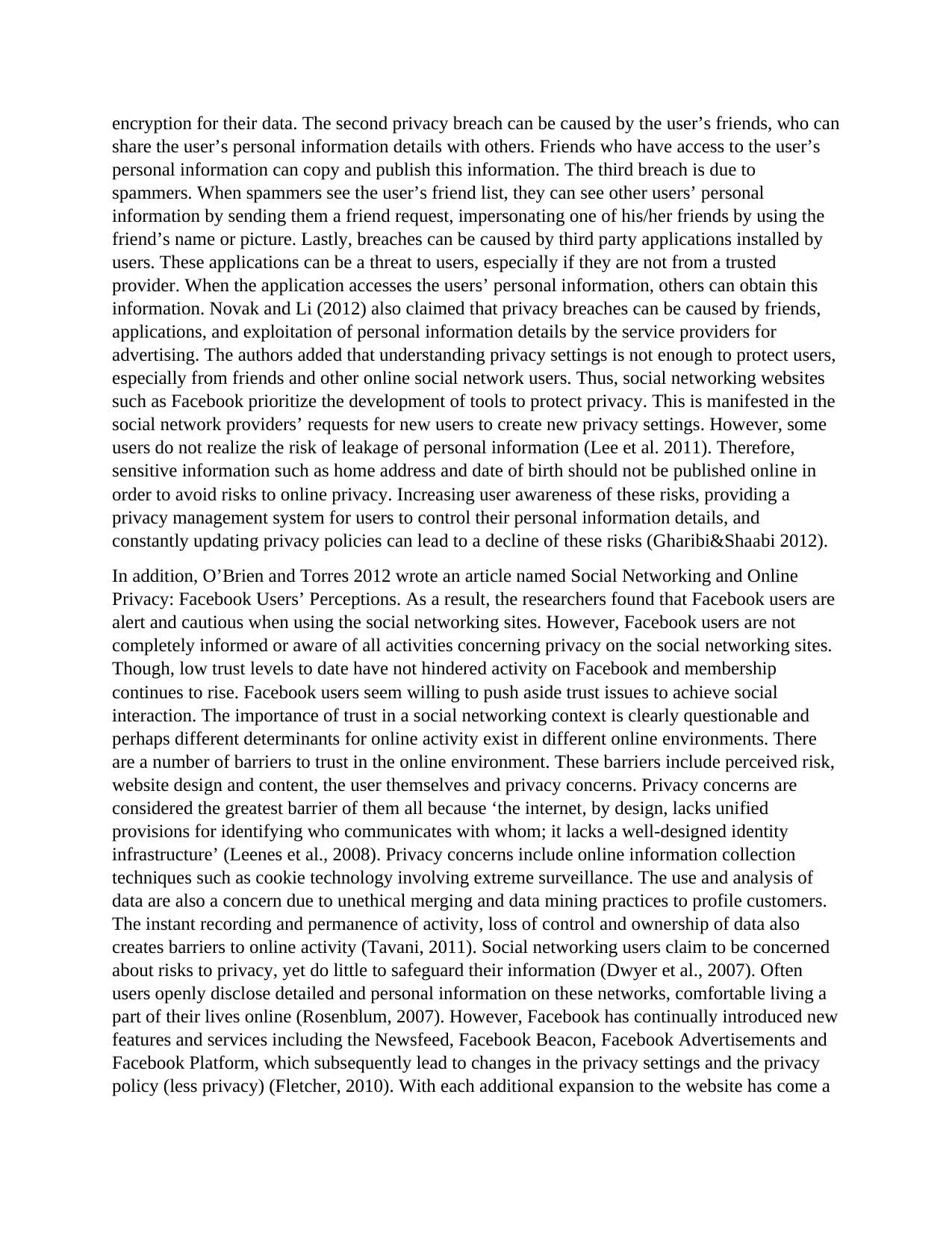
encryption for their data. The second privacy breach can be caused by the user’s friends, who can
share the user’s personal information details with others. Friends who have access to the user’s
personal information can copy and publish this information. The third breach is due to
spammers. When spammers see the user’s friend list, they can see other users’ personal
information by sending them a friend request, impersonating one of his/her friends by using the
friend’s name or picture. Lastly, breaches can be caused by third party applications installed by
users. These applications can be a threat to users, especially if they are not from a trusted
provider. When the application accesses the users’ personal information, others can obtain this
information. Novak and Li (2012) also claimed that privacy breaches can be caused by friends,
applications, and exploitation of personal information details by the service providers for
advertising. The authors added that understanding privacy settings is not enough to protect users,
especially from friends and other online social network users. Thus, social networking websites
such as Facebook prioritize the development of tools to protect privacy. This is manifested in the
social network providers’ requests for new users to create new privacy settings. However, some
users do not realize the risk of leakage of personal information (Lee et al. 2011). Therefore,
sensitive information such as home address and date of birth should not be published online in
order to avoid risks to online privacy. Increasing user awareness of these risks, providing a
privacy management system for users to control their personal information details, and
constantly updating privacy policies can lead to a decline of these risks (Gharibi&Shaabi 2012).
In addition, O’Brien and Torres 2012 wrote an article named Social Networking and Online
Privacy: Facebook Users’ Perceptions. As a result, the researchers found that Facebook users are
alert and cautious when using the social networking sites. However, Facebook users are not
completely informed or aware of all activities concerning privacy on the social networking sites.
Though, low trust levels to date have not hindered activity on Facebook and membership
continues to rise. Facebook users seem willing to push aside trust issues to achieve social
interaction. The importance of trust in a social networking context is clearly questionable and
perhaps different determinants for online activity exist in different online environments. There
are a number of barriers to trust in the online environment. These barriers include perceived risk,
website design and content, the user themselves and privacy concerns. Privacy concerns are
considered the greatest barrier of them all because ‘the internet, by design, lacks unified
provisions for identifying who communicates with whom; it lacks a well-designed identity
infrastructure’ (Leenes et al., 2008). Privacy concerns include online information collection
techniques such as cookie technology involving extreme surveillance. The use and analysis of
data are also a concern due to unethical merging and data mining practices to profile customers.
The instant recording and permanence of activity, loss of control and ownership of data also
creates barriers to online activity (Tavani, 2011). Social networking users claim to be concerned
about risks to privacy, yet do little to safeguard their information (Dwyer et al., 2007). Often
users openly disclose detailed and personal information on these networks, comfortable living a
part of their lives online (Rosenblum, 2007). However, Facebook has continually introduced new
features and services including the Newsfeed, Facebook Beacon, Facebook Advertisements and
Facebook Platform, which subsequently lead to changes in the privacy settings and the privacy
policy (less privacy) (Fletcher, 2010). With each additional expansion to the website has come a
share the user’s personal information details with others. Friends who have access to the user’s
personal information can copy and publish this information. The third breach is due to
spammers. When spammers see the user’s friend list, they can see other users’ personal
information by sending them a friend request, impersonating one of his/her friends by using the
friend’s name or picture. Lastly, breaches can be caused by third party applications installed by
users. These applications can be a threat to users, especially if they are not from a trusted
provider. When the application accesses the users’ personal information, others can obtain this
information. Novak and Li (2012) also claimed that privacy breaches can be caused by friends,
applications, and exploitation of personal information details by the service providers for
advertising. The authors added that understanding privacy settings is not enough to protect users,
especially from friends and other online social network users. Thus, social networking websites
such as Facebook prioritize the development of tools to protect privacy. This is manifested in the
social network providers’ requests for new users to create new privacy settings. However, some
users do not realize the risk of leakage of personal information (Lee et al. 2011). Therefore,
sensitive information such as home address and date of birth should not be published online in
order to avoid risks to online privacy. Increasing user awareness of these risks, providing a
privacy management system for users to control their personal information details, and
constantly updating privacy policies can lead to a decline of these risks (Gharibi&Shaabi 2012).
In addition, O’Brien and Torres 2012 wrote an article named Social Networking and Online
Privacy: Facebook Users’ Perceptions. As a result, the researchers found that Facebook users are
alert and cautious when using the social networking sites. However, Facebook users are not
completely informed or aware of all activities concerning privacy on the social networking sites.
Though, low trust levels to date have not hindered activity on Facebook and membership
continues to rise. Facebook users seem willing to push aside trust issues to achieve social
interaction. The importance of trust in a social networking context is clearly questionable and
perhaps different determinants for online activity exist in different online environments. There
are a number of barriers to trust in the online environment. These barriers include perceived risk,
website design and content, the user themselves and privacy concerns. Privacy concerns are
considered the greatest barrier of them all because ‘the internet, by design, lacks unified
provisions for identifying who communicates with whom; it lacks a well-designed identity
infrastructure’ (Leenes et al., 2008). Privacy concerns include online information collection
techniques such as cookie technology involving extreme surveillance. The use and analysis of
data are also a concern due to unethical merging and data mining practices to profile customers.
The instant recording and permanence of activity, loss of control and ownership of data also
creates barriers to online activity (Tavani, 2011). Social networking users claim to be concerned
about risks to privacy, yet do little to safeguard their information (Dwyer et al., 2007). Often
users openly disclose detailed and personal information on these networks, comfortable living a
part of their lives online (Rosenblum, 2007). However, Facebook has continually introduced new
features and services including the Newsfeed, Facebook Beacon, Facebook Advertisements and
Facebook Platform, which subsequently lead to changes in the privacy settings and the privacy
policy (less privacy) (Fletcher, 2010). With each additional expansion to the website has come a
Paraphrase This Document
Need a fresh take? Get an instant paraphrase of this document with our AI Paraphraser
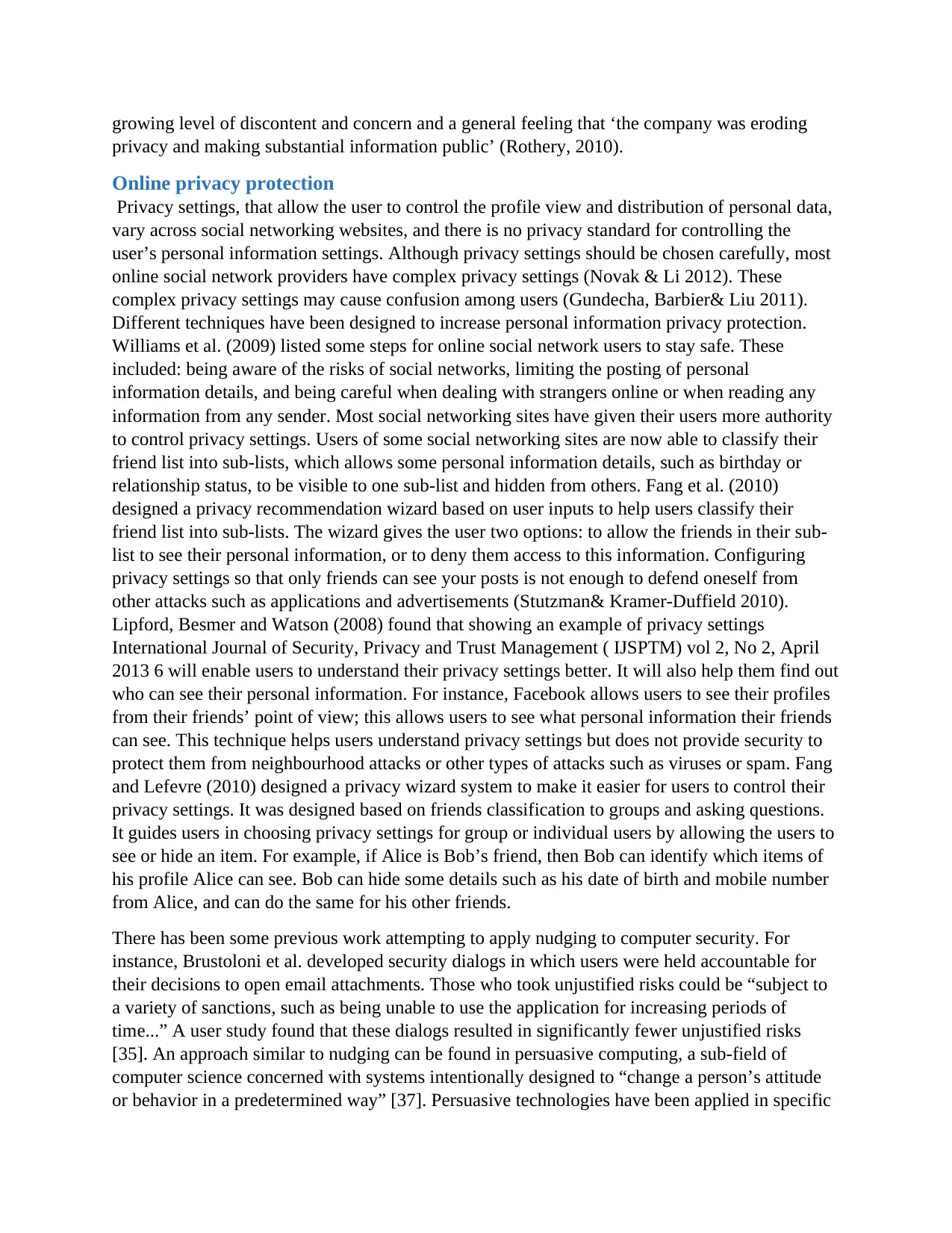
growing level of discontent and concern and a general feeling that ‘the company was eroding
privacy and making substantial information public’ (Rothery, 2010).
Online privacy protection
Privacy settings, that allow the user to control the profile view and distribution of personal data,
vary across social networking websites, and there is no privacy standard for controlling the
user’s personal information settings. Although privacy settings should be chosen carefully, most
online social network providers have complex privacy settings (Novak & Li 2012). These
complex privacy settings may cause confusion among users (Gundecha, Barbier& Liu 2011).
Different techniques have been designed to increase personal information privacy protection.
Williams et al. (2009) listed some steps for online social network users to stay safe. These
included: being aware of the risks of social networks, limiting the posting of personal
information details, and being careful when dealing with strangers online or when reading any
information from any sender. Most social networking sites have given their users more authority
to control privacy settings. Users of some social networking sites are now able to classify their
friend list into sub-lists, which allows some personal information details, such as birthday or
relationship status, to be visible to one sub-list and hidden from others. Fang et al. (2010)
designed a privacy recommendation wizard based on user inputs to help users classify their
friend list into sub-lists. The wizard gives the user two options: to allow the friends in their sub-
list to see their personal information, or to deny them access to this information. Configuring
privacy settings so that only friends can see your posts is not enough to defend oneself from
other attacks such as applications and advertisements (Stutzman& Kramer-Duffield 2010).
Lipford, Besmer and Watson (2008) found that showing an example of privacy settings
International Journal of Security, Privacy and Trust Management ( IJSPTM) vol 2, No 2, April
2013 6 will enable users to understand their privacy settings better. It will also help them find out
who can see their personal information. For instance, Facebook allows users to see their profiles
from their friends’ point of view; this allows users to see what personal information their friends
can see. This technique helps users understand privacy settings but does not provide security to
protect them from neighbourhood attacks or other types of attacks such as viruses or spam. Fang
and Lefevre (2010) designed a privacy wizard system to make it easier for users to control their
privacy settings. It was designed based on friends classification to groups and asking questions.
It guides users in choosing privacy settings for group or individual users by allowing the users to
see or hide an item. For example, if Alice is Bob’s friend, then Bob can identify which items of
his profile Alice can see. Bob can hide some details such as his date of birth and mobile number
from Alice, and can do the same for his other friends.
There has been some previous work attempting to apply nudging to computer security. For
instance, Brustoloni et al. developed security dialogs in which users were held accountable for
their decisions to open email attachments. Those who took unjustified risks could be “subject to
a variety of sanctions, such as being unable to use the application for increasing periods of
time...” A user study found that these dialogs resulted in significantly fewer unjustified risks
[35]. An approach similar to nudging can be found in persuasive computing, a sub-field of
computer science concerned with systems intentionally designed to “change a person’s attitude
or behavior in a predetermined way” [37]. Persuasive technologies have been applied in specific
privacy and making substantial information public’ (Rothery, 2010).
Online privacy protection
Privacy settings, that allow the user to control the profile view and distribution of personal data,
vary across social networking websites, and there is no privacy standard for controlling the
user’s personal information settings. Although privacy settings should be chosen carefully, most
online social network providers have complex privacy settings (Novak & Li 2012). These
complex privacy settings may cause confusion among users (Gundecha, Barbier& Liu 2011).
Different techniques have been designed to increase personal information privacy protection.
Williams et al. (2009) listed some steps for online social network users to stay safe. These
included: being aware of the risks of social networks, limiting the posting of personal
information details, and being careful when dealing with strangers online or when reading any
information from any sender. Most social networking sites have given their users more authority
to control privacy settings. Users of some social networking sites are now able to classify their
friend list into sub-lists, which allows some personal information details, such as birthday or
relationship status, to be visible to one sub-list and hidden from others. Fang et al. (2010)
designed a privacy recommendation wizard based on user inputs to help users classify their
friend list into sub-lists. The wizard gives the user two options: to allow the friends in their sub-
list to see their personal information, or to deny them access to this information. Configuring
privacy settings so that only friends can see your posts is not enough to defend oneself from
other attacks such as applications and advertisements (Stutzman& Kramer-Duffield 2010).
Lipford, Besmer and Watson (2008) found that showing an example of privacy settings
International Journal of Security, Privacy and Trust Management ( IJSPTM) vol 2, No 2, April
2013 6 will enable users to understand their privacy settings better. It will also help them find out
who can see their personal information. For instance, Facebook allows users to see their profiles
from their friends’ point of view; this allows users to see what personal information their friends
can see. This technique helps users understand privacy settings but does not provide security to
protect them from neighbourhood attacks or other types of attacks such as viruses or spam. Fang
and Lefevre (2010) designed a privacy wizard system to make it easier for users to control their
privacy settings. It was designed based on friends classification to groups and asking questions.
It guides users in choosing privacy settings for group or individual users by allowing the users to
see or hide an item. For example, if Alice is Bob’s friend, then Bob can identify which items of
his profile Alice can see. Bob can hide some details such as his date of birth and mobile number
from Alice, and can do the same for his other friends.
There has been some previous work attempting to apply nudging to computer security. For
instance, Brustoloni et al. developed security dialogs in which users were held accountable for
their decisions to open email attachments. Those who took unjustified risks could be “subject to
a variety of sanctions, such as being unable to use the application for increasing periods of
time...” A user study found that these dialogs resulted in significantly fewer unjustified risks
[35]. An approach similar to nudging can be found in persuasive computing, a sub-field of
computer science concerned with systems intentionally designed to “change a person’s attitude
or behavior in a predetermined way” [37]. Persuasive technologies have been applied in specific
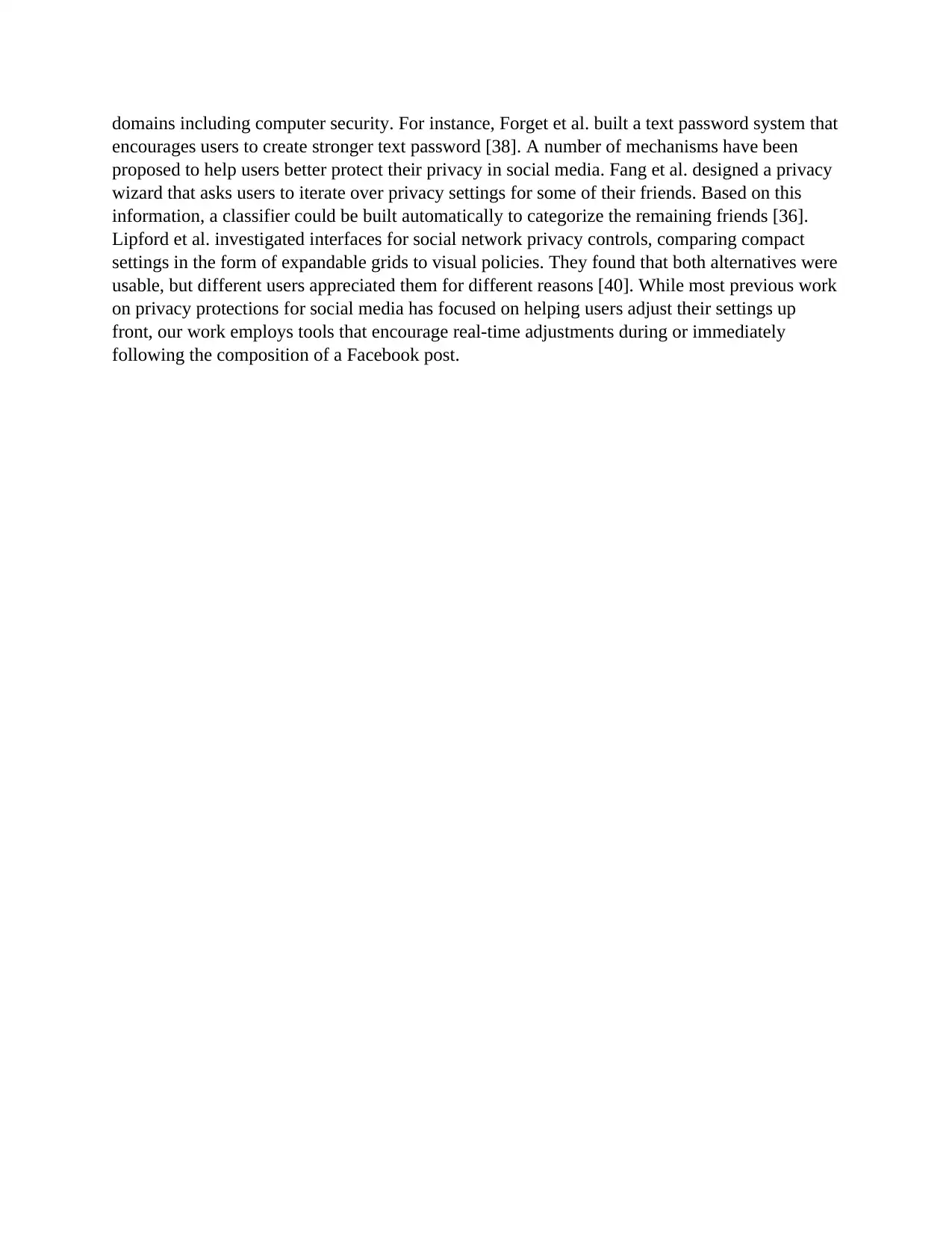
domains including computer security. For instance, Forget et al. built a text password system that
encourages users to create stronger text password [38]. A number of mechanisms have been
proposed to help users better protect their privacy in social media. Fang et al. designed a privacy
wizard that asks users to iterate over privacy settings for some of their friends. Based on this
information, a classifier could be built automatically to categorize the remaining friends [36].
Lipford et al. investigated interfaces for social network privacy controls, comparing compact
settings in the form of expandable grids to visual policies. They found that both alternatives were
usable, but different users appreciated them for different reasons [40]. While most previous work
on privacy protections for social media has focused on helping users adjust their settings up
front, our work employs tools that encourage real-time adjustments during or immediately
following the composition of a Facebook post.
encourages users to create stronger text password [38]. A number of mechanisms have been
proposed to help users better protect their privacy in social media. Fang et al. designed a privacy
wizard that asks users to iterate over privacy settings for some of their friends. Based on this
information, a classifier could be built automatically to categorize the remaining friends [36].
Lipford et al. investigated interfaces for social network privacy controls, comparing compact
settings in the form of expandable grids to visual policies. They found that both alternatives were
usable, but different users appreciated them for different reasons [40]. While most previous work
on privacy protections for social media has focused on helping users adjust their settings up
front, our work employs tools that encourage real-time adjustments during or immediately
following the composition of a Facebook post.
⊘ This is a preview!⊘
Do you want full access?
Subscribe today to unlock all pages.

Trusted by 1+ million students worldwide
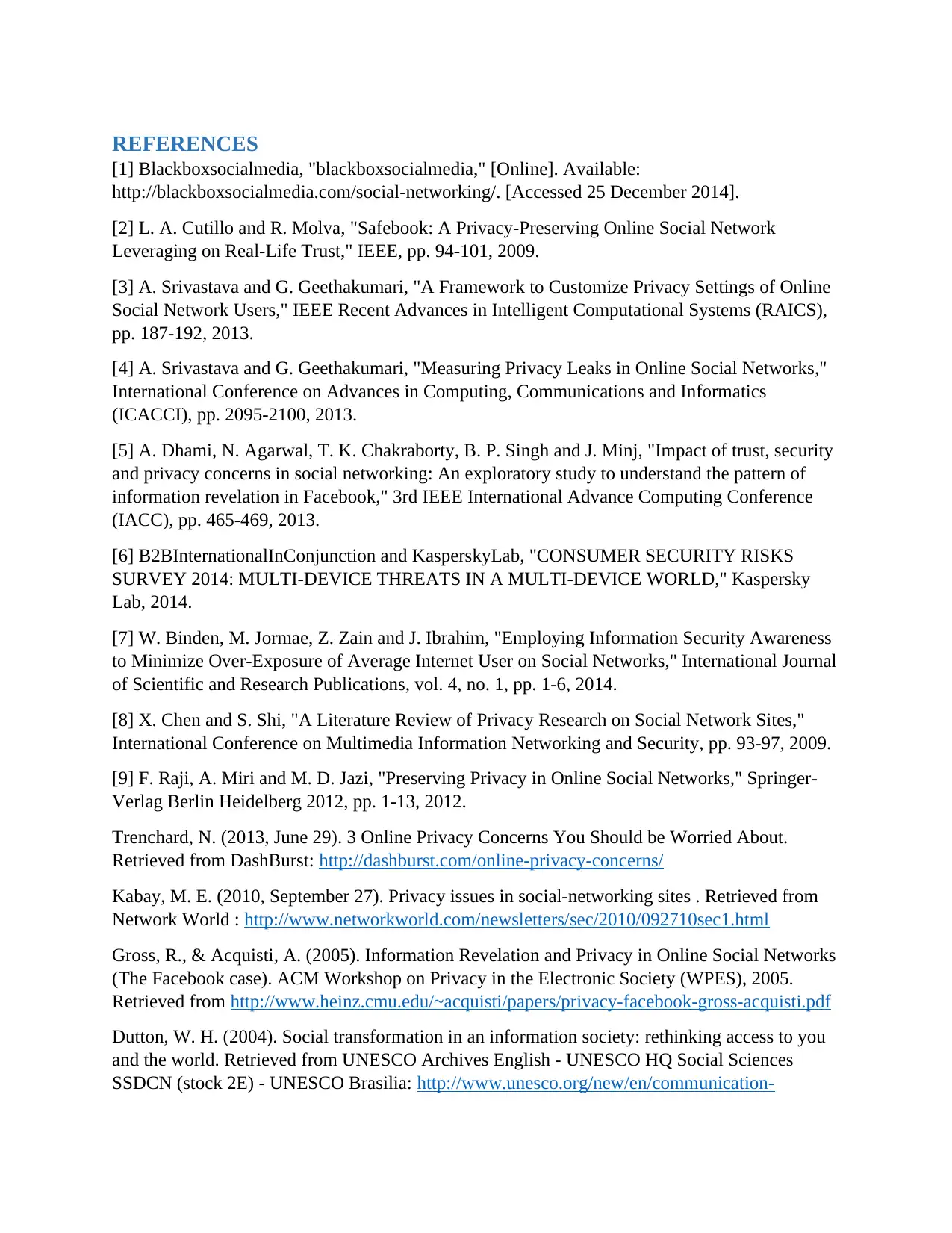
REFERENCES
[1] Blackboxsocialmedia, "blackboxsocialmedia," [Online]. Available:
http://blackboxsocialmedia.com/social-networking/. [Accessed 25 December 2014].
[2] L. A. Cutillo and R. Molva, "Safebook: A Privacy-Preserving Online Social Network
Leveraging on Real-Life Trust," IEEE, pp. 94-101, 2009.
[3] A. Srivastava and G. Geethakumari, "A Framework to Customize Privacy Settings of Online
Social Network Users," IEEE Recent Advances in Intelligent Computational Systems (RAICS),
pp. 187-192, 2013.
[4] A. Srivastava and G. Geethakumari, "Measuring Privacy Leaks in Online Social Networks,"
International Conference on Advances in Computing, Communications and Informatics
(ICACCI), pp. 2095-2100, 2013.
[5] A. Dhami, N. Agarwal, T. K. Chakraborty, B. P. Singh and J. Minj, "Impact of trust, security
and privacy concerns in social networking: An exploratory study to understand the pattern of
information revelation in Facebook," 3rd IEEE International Advance Computing Conference
(IACC), pp. 465-469, 2013.
[6] B2BInternationalInConjunction and KasperskyLab, "CONSUMER SECURITY RISKS
SURVEY 2014: MULTI-DEVICE THREATS IN A MULTI-DEVICE WORLD," Kaspersky
Lab, 2014.
[7] W. Binden, M. Jormae, Z. Zain and J. Ibrahim, "Employing Information Security Awareness
to Minimize Over-Exposure of Average Internet User on Social Networks," International Journal
of Scientific and Research Publications, vol. 4, no. 1, pp. 1-6, 2014.
[8] X. Chen and S. Shi, "A Literature Review of Privacy Research on Social Network Sites,"
International Conference on Multimedia Information Networking and Security, pp. 93-97, 2009.
[9] F. Raji, A. Miri and M. D. Jazi, "Preserving Privacy in Online Social Networks," Springer-
Verlag Berlin Heidelberg 2012, pp. 1-13, 2012.
Trenchard, N. (2013, June 29). 3 Online Privacy Concerns You Should be Worried About.
Retrieved from DashBurst: http://dashburst.com/online-privacy-concerns/
Kabay, M. E. (2010, September 27). Privacy issues in social-networking sites . Retrieved from
Network World : http://www.networkworld.com/newsletters/sec/2010/092710sec1.html
Gross, R., & Acquisti, A. (2005). Information Revelation and Privacy in Online Social Networks
(The Facebook case). ACM Workshop on Privacy in the Electronic Society (WPES), 2005.
Retrieved from http://www.heinz.cmu.edu/~acquisti/papers/privacy-facebook-gross-acquisti.pdf
Dutton, W. H. (2004). Social transformation in an information society: rethinking access to you
and the world. Retrieved from UNESCO Archives English - UNESCO HQ Social Sciences
SSDCN (stock 2E) - UNESCO Brasilia: http://www.unesco.org/new/en/communication-
[1] Blackboxsocialmedia, "blackboxsocialmedia," [Online]. Available:
http://blackboxsocialmedia.com/social-networking/. [Accessed 25 December 2014].
[2] L. A. Cutillo and R. Molva, "Safebook: A Privacy-Preserving Online Social Network
Leveraging on Real-Life Trust," IEEE, pp. 94-101, 2009.
[3] A. Srivastava and G. Geethakumari, "A Framework to Customize Privacy Settings of Online
Social Network Users," IEEE Recent Advances in Intelligent Computational Systems (RAICS),
pp. 187-192, 2013.
[4] A. Srivastava and G. Geethakumari, "Measuring Privacy Leaks in Online Social Networks,"
International Conference on Advances in Computing, Communications and Informatics
(ICACCI), pp. 2095-2100, 2013.
[5] A. Dhami, N. Agarwal, T. K. Chakraborty, B. P. Singh and J. Minj, "Impact of trust, security
and privacy concerns in social networking: An exploratory study to understand the pattern of
information revelation in Facebook," 3rd IEEE International Advance Computing Conference
(IACC), pp. 465-469, 2013.
[6] B2BInternationalInConjunction and KasperskyLab, "CONSUMER SECURITY RISKS
SURVEY 2014: MULTI-DEVICE THREATS IN A MULTI-DEVICE WORLD," Kaspersky
Lab, 2014.
[7] W. Binden, M. Jormae, Z. Zain and J. Ibrahim, "Employing Information Security Awareness
to Minimize Over-Exposure of Average Internet User on Social Networks," International Journal
of Scientific and Research Publications, vol. 4, no. 1, pp. 1-6, 2014.
[8] X. Chen and S. Shi, "A Literature Review of Privacy Research on Social Network Sites,"
International Conference on Multimedia Information Networking and Security, pp. 93-97, 2009.
[9] F. Raji, A. Miri and M. D. Jazi, "Preserving Privacy in Online Social Networks," Springer-
Verlag Berlin Heidelberg 2012, pp. 1-13, 2012.
Trenchard, N. (2013, June 29). 3 Online Privacy Concerns You Should be Worried About.
Retrieved from DashBurst: http://dashburst.com/online-privacy-concerns/
Kabay, M. E. (2010, September 27). Privacy issues in social-networking sites . Retrieved from
Network World : http://www.networkworld.com/newsletters/sec/2010/092710sec1.html
Gross, R., & Acquisti, A. (2005). Information Revelation and Privacy in Online Social Networks
(The Facebook case). ACM Workshop on Privacy in the Electronic Society (WPES), 2005.
Retrieved from http://www.heinz.cmu.edu/~acquisti/papers/privacy-facebook-gross-acquisti.pdf
Dutton, W. H. (2004). Social transformation in an information society: rethinking access to you
and the world. Retrieved from UNESCO Archives English - UNESCO HQ Social Sciences
SSDCN (stock 2E) - UNESCO Brasilia: http://www.unesco.org/new/en/communication-
Paraphrase This Document
Need a fresh take? Get an instant paraphrase of this document with our AI Paraphraser
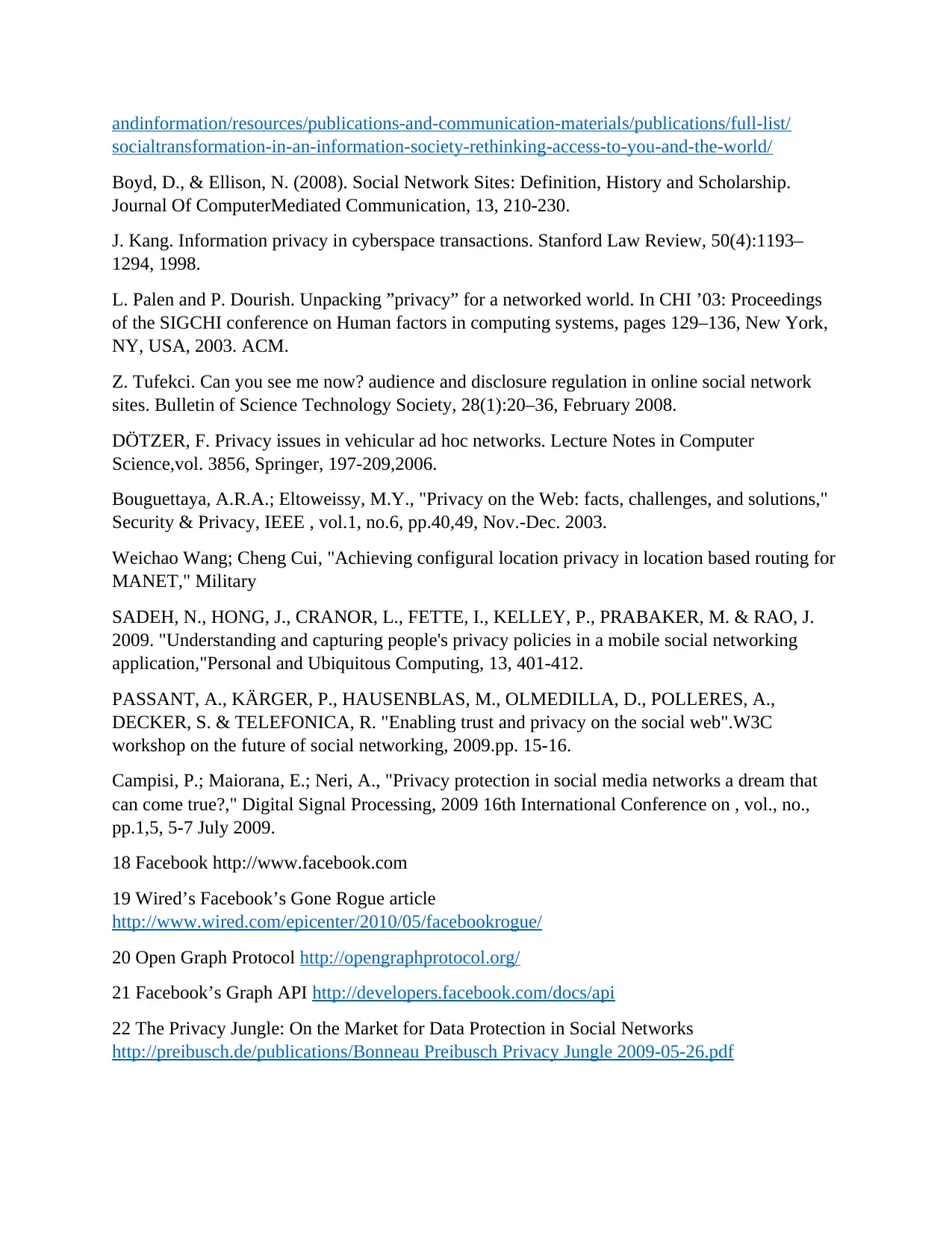
andinformation/resources/publications-and-communication-materials/publications/full-list/
socialtransformation-in-an-information-society-rethinking-access-to-you-and-the-world/
Boyd, D., & Ellison, N. (2008). Social Network Sites: Definition, History and Scholarship.
Journal Of ComputerMediated Communication, 13, 210-230.
J. Kang. Information privacy in cyberspace transactions. Stanford Law Review, 50(4):1193–
1294, 1998.
L. Palen and P. Dourish. Unpacking ”privacy” for a networked world. In CHI ’03: Proceedings
of the SIGCHI conference on Human factors in computing systems, pages 129–136, New York,
NY, USA, 2003. ACM.
Z. Tufekci. Can you see me now? audience and disclosure regulation in online social network
sites. Bulletin of Science Technology Society, 28(1):20–36, February 2008.
DÖTZER, F. Privacy issues in vehicular ad hoc networks. Lecture Notes in Computer
Science,vol. 3856, Springer, 197-209,2006.
Bouguettaya, A.R.A.; Eltoweissy, M.Y., "Privacy on the Web: facts, challenges, and solutions,"
Security & Privacy, IEEE , vol.1, no.6, pp.40,49, Nov.-Dec. 2003.
Weichao Wang; Cheng Cui, "Achieving configural location privacy in location based routing for
MANET," Military
SADEH, N., HONG, J., CRANOR, L., FETTE, I., KELLEY, P., PRABAKER, M. & RAO, J.
2009. "Understanding and capturing people's privacy policies in a mobile social networking
application,"Personal and Ubiquitous Computing, 13, 401-412.
PASSANT, A., KÄRGER, P., HAUSENBLAS, M., OLMEDILLA, D., POLLERES, A.,
DECKER, S. & TELEFONICA, R. "Enabling trust and privacy on the social web".W3C
workshop on the future of social networking, 2009.pp. 15-16.
Campisi, P.; Maiorana, E.; Neri, A., "Privacy protection in social media networks a dream that
can come true?," Digital Signal Processing, 2009 16th International Conference on , vol., no.,
pp.1,5, 5-7 July 2009.
18 Facebook http://www.facebook.com
19 Wired’s Facebook’s Gone Rogue article
http://www.wired.com/epicenter/2010/05/facebookrogue/
20 Open Graph Protocol http://opengraphprotocol.org/
21 Facebook’s Graph API http://developers.facebook.com/docs/api
22 The Privacy Jungle: On the Market for Data Protection in Social Networks
http://preibusch.de/publications/Bonneau Preibusch Privacy Jungle 2009-05-26.pdf
socialtransformation-in-an-information-society-rethinking-access-to-you-and-the-world/
Boyd, D., & Ellison, N. (2008). Social Network Sites: Definition, History and Scholarship.
Journal Of ComputerMediated Communication, 13, 210-230.
J. Kang. Information privacy in cyberspace transactions. Stanford Law Review, 50(4):1193–
1294, 1998.
L. Palen and P. Dourish. Unpacking ”privacy” for a networked world. In CHI ’03: Proceedings
of the SIGCHI conference on Human factors in computing systems, pages 129–136, New York,
NY, USA, 2003. ACM.
Z. Tufekci. Can you see me now? audience and disclosure regulation in online social network
sites. Bulletin of Science Technology Society, 28(1):20–36, February 2008.
DÖTZER, F. Privacy issues in vehicular ad hoc networks. Lecture Notes in Computer
Science,vol. 3856, Springer, 197-209,2006.
Bouguettaya, A.R.A.; Eltoweissy, M.Y., "Privacy on the Web: facts, challenges, and solutions,"
Security & Privacy, IEEE , vol.1, no.6, pp.40,49, Nov.-Dec. 2003.
Weichao Wang; Cheng Cui, "Achieving configural location privacy in location based routing for
MANET," Military
SADEH, N., HONG, J., CRANOR, L., FETTE, I., KELLEY, P., PRABAKER, M. & RAO, J.
2009. "Understanding and capturing people's privacy policies in a mobile social networking
application,"Personal and Ubiquitous Computing, 13, 401-412.
PASSANT, A., KÄRGER, P., HAUSENBLAS, M., OLMEDILLA, D., POLLERES, A.,
DECKER, S. & TELEFONICA, R. "Enabling trust and privacy on the social web".W3C
workshop on the future of social networking, 2009.pp. 15-16.
Campisi, P.; Maiorana, E.; Neri, A., "Privacy protection in social media networks a dream that
can come true?," Digital Signal Processing, 2009 16th International Conference on , vol., no.,
pp.1,5, 5-7 July 2009.
18 Facebook http://www.facebook.com
19 Wired’s Facebook’s Gone Rogue article
http://www.wired.com/epicenter/2010/05/facebookrogue/
20 Open Graph Protocol http://opengraphprotocol.org/
21 Facebook’s Graph API http://developers.facebook.com/docs/api
22 The Privacy Jungle: On the Market for Data Protection in Social Networks
http://preibusch.de/publications/Bonneau Preibusch Privacy Jungle 2009-05-26.pdf
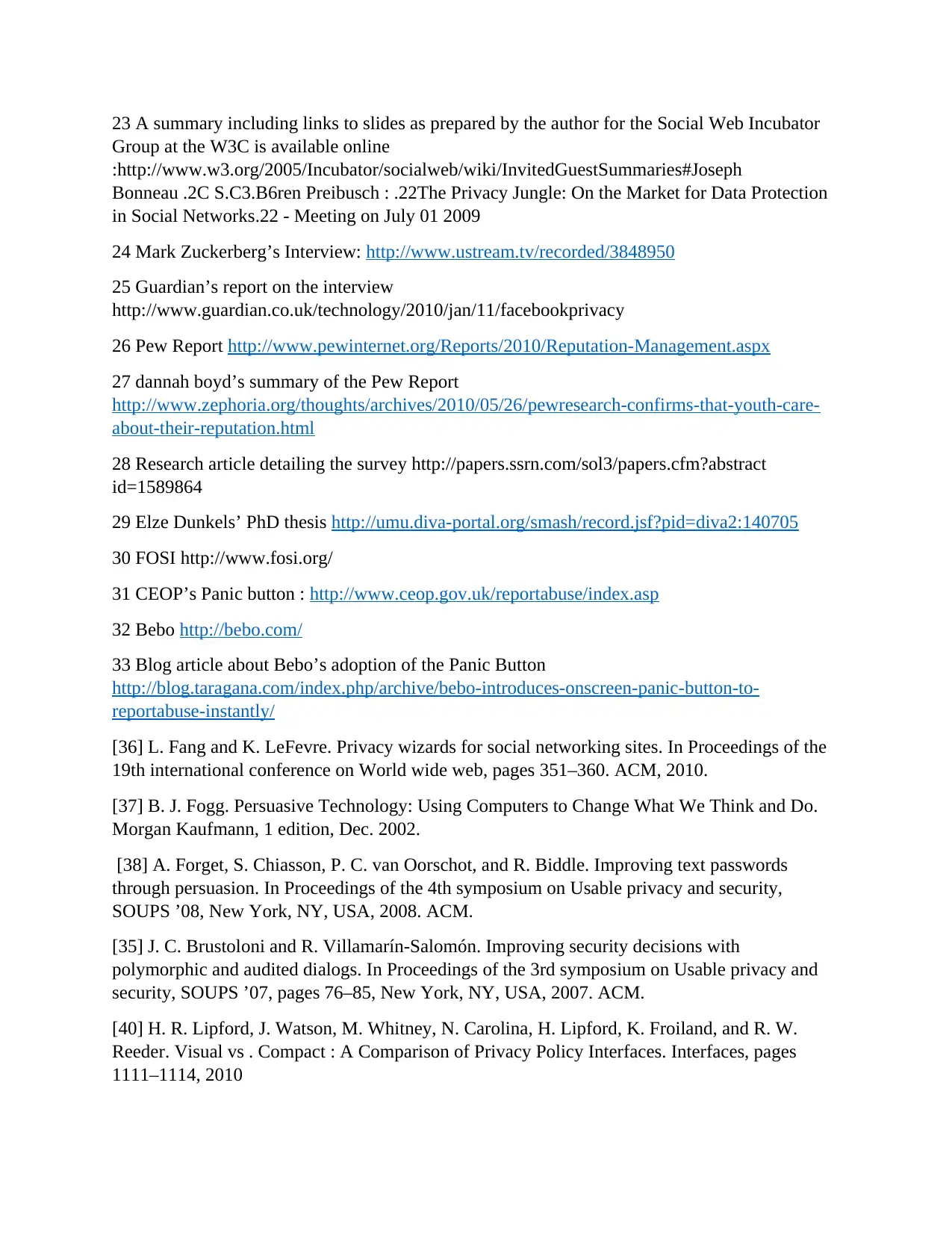
23 A summary including links to slides as prepared by the author for the Social Web Incubator
Group at the W3C is available online
:http://www.w3.org/2005/Incubator/socialweb/wiki/InvitedGuestSummaries#Joseph
Bonneau .2C S.C3.B6ren Preibusch : .22The Privacy Jungle: On the Market for Data Protection
in Social Networks.22 - Meeting on July 01 2009
24 Mark Zuckerberg’s Interview: http://www.ustream.tv/recorded/3848950
25 Guardian’s report on the interview
http://www.guardian.co.uk/technology/2010/jan/11/facebookprivacy
26 Pew Report http://www.pewinternet.org/Reports/2010/Reputation-Management.aspx
27 dannah boyd’s summary of the Pew Report
http://www.zephoria.org/thoughts/archives/2010/05/26/pewresearch-confirms-that-youth-care-
about-their-reputation.html
28 Research article detailing the survey http://papers.ssrn.com/sol3/papers.cfm?abstract
id=1589864
29 Elze Dunkels’ PhD thesis http://umu.diva-portal.org/smash/record.jsf?pid=diva2:140705
30 FOSI http://www.fosi.org/
31 CEOP’s Panic button : http://www.ceop.gov.uk/reportabuse/index.asp
32 Bebo http://bebo.com/
33 Blog article about Bebo’s adoption of the Panic Button
http://blog.taragana.com/index.php/archive/bebo-introduces-onscreen-panic-button-to-
reportabuse-instantly/
[36] L. Fang and K. LeFevre. Privacy wizards for social networking sites. In Proceedings of the
19th international conference on World wide web, pages 351–360. ACM, 2010.
[37] B. J. Fogg. Persuasive Technology: Using Computers to Change What We Think and Do.
Morgan Kaufmann, 1 edition, Dec. 2002.
[38] A. Forget, S. Chiasson, P. C. van Oorschot, and R. Biddle. Improving text passwords
through persuasion. In Proceedings of the 4th symposium on Usable privacy and security,
SOUPS ’08, New York, NY, USA, 2008. ACM.
[35] J. C. Brustoloni and R. Villamarín-Salomón. Improving security decisions with
polymorphic and audited dialogs. In Proceedings of the 3rd symposium on Usable privacy and
security, SOUPS ’07, pages 76–85, New York, NY, USA, 2007. ACM.
[40] H. R. Lipford, J. Watson, M. Whitney, N. Carolina, H. Lipford, K. Froiland, and R. W.
Reeder. Visual vs . Compact : A Comparison of Privacy Policy Interfaces. Interfaces, pages
1111–1114, 2010
Group at the W3C is available online
:http://www.w3.org/2005/Incubator/socialweb/wiki/InvitedGuestSummaries#Joseph
Bonneau .2C S.C3.B6ren Preibusch : .22The Privacy Jungle: On the Market for Data Protection
in Social Networks.22 - Meeting on July 01 2009
24 Mark Zuckerberg’s Interview: http://www.ustream.tv/recorded/3848950
25 Guardian’s report on the interview
http://www.guardian.co.uk/technology/2010/jan/11/facebookprivacy
26 Pew Report http://www.pewinternet.org/Reports/2010/Reputation-Management.aspx
27 dannah boyd’s summary of the Pew Report
http://www.zephoria.org/thoughts/archives/2010/05/26/pewresearch-confirms-that-youth-care-
about-their-reputation.html
28 Research article detailing the survey http://papers.ssrn.com/sol3/papers.cfm?abstract
id=1589864
29 Elze Dunkels’ PhD thesis http://umu.diva-portal.org/smash/record.jsf?pid=diva2:140705
30 FOSI http://www.fosi.org/
31 CEOP’s Panic button : http://www.ceop.gov.uk/reportabuse/index.asp
32 Bebo http://bebo.com/
33 Blog article about Bebo’s adoption of the Panic Button
http://blog.taragana.com/index.php/archive/bebo-introduces-onscreen-panic-button-to-
reportabuse-instantly/
[36] L. Fang and K. LeFevre. Privacy wizards for social networking sites. In Proceedings of the
19th international conference on World wide web, pages 351–360. ACM, 2010.
[37] B. J. Fogg. Persuasive Technology: Using Computers to Change What We Think and Do.
Morgan Kaufmann, 1 edition, Dec. 2002.
[38] A. Forget, S. Chiasson, P. C. van Oorschot, and R. Biddle. Improving text passwords
through persuasion. In Proceedings of the 4th symposium on Usable privacy and security,
SOUPS ’08, New York, NY, USA, 2008. ACM.
[35] J. C. Brustoloni and R. Villamarín-Salomón. Improving security decisions with
polymorphic and audited dialogs. In Proceedings of the 3rd symposium on Usable privacy and
security, SOUPS ’07, pages 76–85, New York, NY, USA, 2007. ACM.
[40] H. R. Lipford, J. Watson, M. Whitney, N. Carolina, H. Lipford, K. Froiland, and R. W.
Reeder. Visual vs . Compact : A Comparison of Privacy Policy Interfaces. Interfaces, pages
1111–1114, 2010
⊘ This is a preview!⊘
Do you want full access?
Subscribe today to unlock all pages.

Trusted by 1+ million students worldwide
1 out of 12
Related Documents
Your All-in-One AI-Powered Toolkit for Academic Success.
+13062052269
info@desklib.com
Available 24*7 on WhatsApp / Email
![[object Object]](/_next/static/media/star-bottom.7253800d.svg)
Unlock your academic potential
Copyright © 2020–2025 A2Z Services. All Rights Reserved. Developed and managed by ZUCOL.





